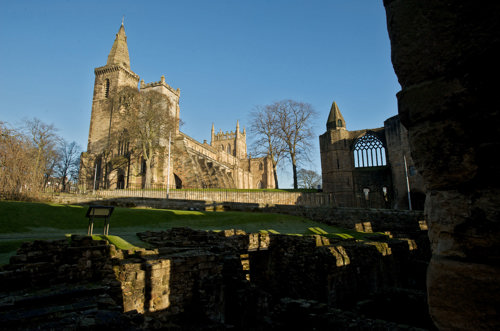Led by University of Stirling historian Dr. Michael Penman, the three-year partnership project with Historic Environment Scotland (HES) used a series of ground-penetrating radar surveys to study the Abbey, with the results allowing the team to create a speculative plan of the lost medieval choir – an area left ruinous following the Protestant Reformation in 1560.
The surveys provided evidence of more than 15 potential elite burials. These were focused on the Abbey’s 14th century Lady Chapel and aisle, as well as around the east end pilgrimage shrine erected c.1250 for royal saint Margaret, queen of Malcolm III (d.1093). The surveys also found radar and archival evidence for the lost high altar settings of the Abbey choir and a formerly unnoticed southern transept chapel and aisle dedicated to St John the Baptist.
Radar and archival evidence were also uncovered raising questions about the true grave site of Bruce, Robert I King of Scots (1306-29).
Richard Strachan, Head of Cultural Resources at HES said: "This project has been very significant in reinforcing the importance of the role of the Abbey church as a royal mausoleum. The royal burials are a key aspect of the history of the Abbey so obtaining a better understanding of this greatly aids our management, conservation and presentation of the wider areas of the site, as well as bringing an enhanced level of academic rigour to our knowledge of the mausoleum.
"This research, using state of the art techniques and expertise, has provided a stronger foundation for understanding the development of this aspect of the site’s history and will inform how we present and interpret the site in the future."
Dr Penman said: "In 1818, architect William Burn uncovered a grave and a lead-encased skeleton, which was generally accepted as being Bruce’s remains. However, combining our radar evidence with measurements taken by local historian Ebenezer Henderson in 1854, it raises the likelihood that the position of this original grave site was too close to the screened high altar for it to have been the original burial suit – in this position, it would have impeded the chancel steps, liturgy of the mass and been obscured to visitors in the aisles.
"One possibility is that this site was a ‘rescue’ burial by monks who reportedly stayed on at Dunfermline until around 1580, in defiance of the Reformation, and who perhaps saved these remains after a box tomb was destroyed. That would explain why this skeleton was found covered in a late 16th or 17th century ‘anthropomorphic’ lead shroud in quite a shallow, crude grave slot.
"Through this study, we also found potential evidence of the existence of double tombs, and it could also have been the case that Bruce was originally buried within the northern central presbytery of the choir, together with his Queen, Elizabeth de Burgh."

Background
The radar surveys, led by Erica Carrick Utsi of EMC Radar Consulting, took in a mixture of interior and exterior areas of the Abbey Church. Using two frequencies the scans probed down to a depth of two metres in search of medieval features.
Dunfermline’s Benedictine Abbey, founded by King David I c.1128, is one of Scotland's most important cultural sites and has received more of Scotland’s royal dead than any other place in the kingdom, excepting Iona. In 2021, the ‘new’ Abbey Church, which was built atop the medieval choir ruins and opened for public worship in 1821, will celebrate its bicentennial year.
The research was initiated in 2015 by the Abbey Church of Dunfermline Kirk Session (Church of Scotland) and through to 2020 in partnership with Fife Council and Historic Environment Scotland. It was funded by grants from the GWS Barrow Award, the Strathmartine and Hunter Archaeological Trusts, the Royal Society of Edinburgh, and the University of Stirling’s Faculty of Arts & Humanities.
The full 164 page illustrated report can be downloaded in full for free from either the project website or from Historic Environment Scotland’s Canmore database.

